-
Car Reviews
- All reviews
- Midsize SUVs
- Small cars
- Utes
- Small SUVs
- Large SUVs
- Large cars
- Sports SUVs
- Sports cars
- Vans
Latest reviews
- Car News
-
Car Comparisons
Latest comparisons
- Chasing Deals
Much like the lauded Porsche Taycan, the Kia EV6 is a very good car first – and a very good electric car second
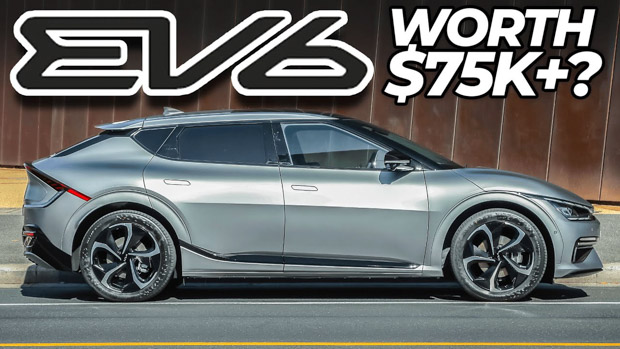
Among the three variants of Kia EV6 sold to Australians – admittedly in very limited numbers throughout 2022 – the middle-tier, $74,990 GT-Line RWD stands out clearly as the best.
It might lack the urge of the dual-motor GT-Line AWD ($82,990), but the highly-specified GT-Line RWD also lacks the AWD’s additional 100kg over the front axle, endowing it with noticeably better handling.
That weight saving also means that the single-motor EV6’s 168kW/350Nm outputs are more than enough to give this car a swift persona and throttle-steerable driving characteristics.
Australian buyers who loved this country’s home-grown six-cylinder sedans with their supple suspension, ample torque and driver-centric handling will feel right at home in the EV6, even if this Kia’s powertrain tech is worlds away from a Commodore or Falcon.
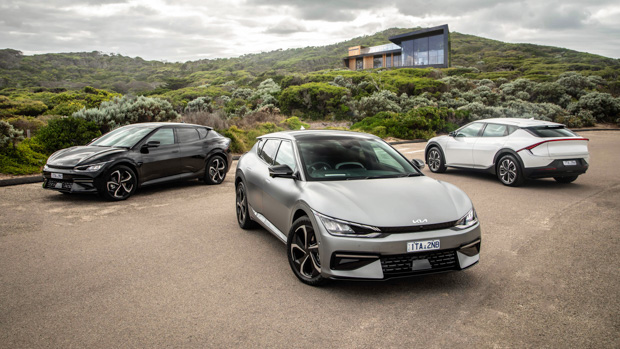
The recipe is remarkably similar: an Australian suspension tune designed realistically for our often harsh road surfaces, combined with adequate power and a long wheelbase for lots of interior and cargo space.
All of that means the strict limits on supply for the EV6 in Australia are a real shame – just 500 units have been confirmed for the entirety of 2022, though Kia hopes to nab another 50 cars or so. Allocation of the cars that are arriving has been left entirely up to dealers, though Kia Australia says margins have been agreed and that mark-ups will not be tolerated.
Three variants are available, from a base-spec Air ($67,990 before on-road costs) with plastic cladding outside and manual cloth seats inside – undercutting the Ioniq 5 on price if not specification – before the range steps up to the considerably more lavish GT-Line ($74,990 RWD, $82,990 dual-motor AWD) with its more plush interior, sportier front- and rear-end treatment and colour-coded bumpers. Later in 2022, a full-fat, 430kW EV6 GT will arrive in Australia.
Out of the three, it’s the GT-Line RWD that we found the most charming. Read on to find out why.
In the same vein as the lauded Porsche Taycan, the Kia EV6 is a great car to drive not because it is electric, but because the ride and handling are so well executed. The electric bit is certainly impressive, and a real environmental bonus, but it isn’t the star of the show.
Rather than running with an overseas suspension tune (like the EV6’s cousin, the Hyundai Ioniq 5), Kia Australia insisted on conducting an in-country rethink of the ride on tough tarmac outside Healesville, Victoria.
A challenging effort that occurred with a small team during the Delta wave of the Covid-19 pandemic, it’s surprising this was able to be pulled off – but the result is a conclusively better ride than not just the Ioniq 5 but every other EV we’ve tested under $100,000.
Built around luxury-grade frequency-selective dampers built by ZF Sachs, the EV6 has two suspension tunes – one for the 168kW single-motor rear-wheel drive models and another for the 239kW dual-motor all-wheel drive flagship.
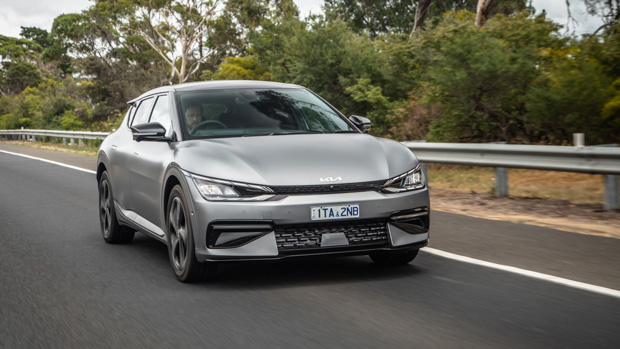
This was necessitated by the complicating effect of the circa-100kg front motor on the AWD model that places noticeable stress on the suspension components, necessitating additional attention to maintain compliance and turn-in bite.
While a reasonable balance of comfort and control has been struck for the impressively quick $83K dual-motor variant, a direct back-to-back drive leaves no doubt that the RWD models are the peaches, with their lighter front end allowing for a less compromised tune.
The RWD models simply ride and handle better, with a fabulous suppleness to the suspension that is a perfect match for pockmarked Australian country roads and suburban potholes alike. Despite their huge (and no doubt heavy) wheels measuring 19-inches on the $68K Air and $75K GT-Line RWD, the EV6’s ride is excellent.
Unfortunately, the steering tune did not receive local attention. Unlike damper selection and tuning, Kia (and Hyundai) say that electric power steering tunes could not be completed in Australia during the pandemic as the software firm involved insists on sending one of their own engineers out from Korea (which travel bans and quarantine ruled out).
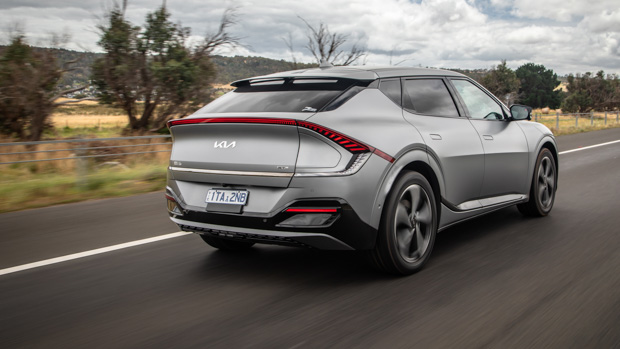
Instead, Kia Australia engineers sent Korea their ideas for the steering tune and these were implemented by correspondence. The end result isn’t bad, but there’s a stodginess to the steering rack that dampens cornering engagement when we know Kia Australia can achieve better here. Now that borders are open, a retune is possible.
So the RWD is the ride/handling pick – but is it enough? We think so. It might weigh in at a stout 2000kg, but the instantaneously delivered 168kW/350Nm is enough to motivate the single-motor EV6 from 0-100km/h in 7.3sec. Like many EVs, the Kia accelerates strongly from rest but there’s ample overtaking power here too.
Beyond mere straight-line performance, the RWD versions offer real engagement to keen drivers. They’re totally throttle-steerable, like a big Australian-made rear-driver or a BMW 3 Series. Even with stability control left on you can tidy up your line in a corner by gently feeding in throttle, or lift to cinch the nose in. Turn ESC off and it’ll drift, easily…
Supplement the set-up with a 74kW/255Nm front motor and total outputs head up to 239kW/605Nm while the 0-100km/h time is slashed to 5.2sec. Noticeably quicker everywhere but not as sweet to chuck around, the AWD will nonetheless be popular with buyers seeking to amp up the ‘electric’ nature of the experience, whereas the single-motor models feel a bit like a classic, laid-back rear-drive V6.
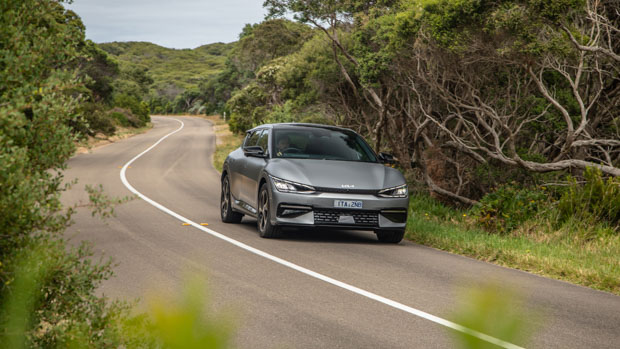
A disconnector-actuator is fitted to the front motor – allowing it to be removed or reconnected from the system within 0.4sec – and when cruising at a steady 100km/h, a live graphic shows that the AWD runs purely rear-drive to save volts.
The motors are fuelled by Hyundai Motor Company’s compact power-electric system that uses hairpin-winding technology and a direct oil cooler. The system is fully integrated into the group’s E-GMP platform that also combines the battery and motors – meaning the wheelbase is scalable for body size and battery modules.
Unlike the Tesla Model 3 (and forthcoming Model Y), regenerative braking is not strong in the EV6 by default. Hit power-on and the Kia is in a light-regen mode on every restart, frustrating those who like one-pedal driving. This feature – branded i-Pedal by Kia – is available and requires tugging the left steering wheel paddle a few times. On the other side of the spectrum, regen can be entirely turned off via the right paddle.
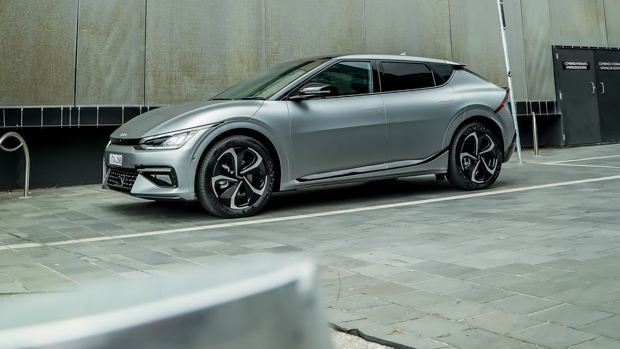
Hauling a load is possible with the EV6 and it’s rated for 1600kg braked towing, though Kia warns that doing so slashes range by a whopping 50 percent from the fairly accurate WLTP driving range estimates of 528km (Air RWD), 504km (GT-Line RWD), and 484km (GT-Line AWD).
On the safety front, the EV6 is pretty well-stocked. We continue to heap praise on Kia’s blind spot camera system which works so intuitively, though this is only available on the GT-Line. All cars have adaptive cruise control and strong lane centring, which relieves fatigue on motorways – plus AEB and rear cross-traffic alert with braking intervention.
While batteries, motors, inverters and other components that go into an electric car are gradually getting cheaper, the R&D that results in a vehicle as complex as the EV6 is still a massive undertaking.
That’s one of the reasons why this midsize SUV is $74,990 in our preferred GT-Line spec, even though the interior feels more suited to a $50,000 Kia Sportage. It’s simply the case that mainstream-brand EVs continue to feel overpriced from inside the cabin, even if the mechanical aspects of the powertrain and chassis are very impressive.
That is also true of the stickily vinyl-upholstered Tesla Model 3 (from $59,900) as it is of the Kia – it is not a problem specific to the EV6. That said, progress is underway – the Polestar 2 (also $59,900) can be optioned with a Nappa leather interior (for another $6000) while the Lexus UX300e Sports Luxury ($81,000) is fabulously well-made but has a short 300km range.
Back to the Kia: the interior is visually impressive, with a huge, curved panel of twin 12.3-inch screens plus a trick floating centre console that integrates the power switch, direction selector, drive modes and other quick-access buttons.

We love the fact that Kia has totally eschewed the vinyl upholstery that is far too common among electric vehicles (being free of animal products, it aligns with the environmental values of some EV buyers). Vinyl feels cheap and in a hot country like Australia, it induces sweat very quickly indeed.
Instead, the EV6 gets pleasant cloth trim in the $68K Air while the GT-Lines have suede-like material with much-appreciated fan cooling that keeps your body very temperate while driving. The electrically adjustable front pews are heated too, so winter will be more than bearable. Both functions are more energy-efficient than blasting air-con at your face.
A major chasm exists between the seat comfort of the Air and GT-Line, though. The GT-Line variants have taller bolsters but the power adjustment of the seat – specifically the under-thigh angle adjust – is almost laughably extensive. If you can’t find a comfy driving position, you’re not trying hard enough. By contrast, the limited manual adjustment of the Air’s seats left our thighs floating.
Kia’s technology works pretty well through the big, matte-coated screens in the EV6. The integrated navigation shows charging locations and there’s Apple CarPlay and Android Auto – though this requires a cable, and the USB port for this is randomly located near the floor. We wish you could customise the driver’s display more with a map and media displays – it looks good but the software is far too basic here.
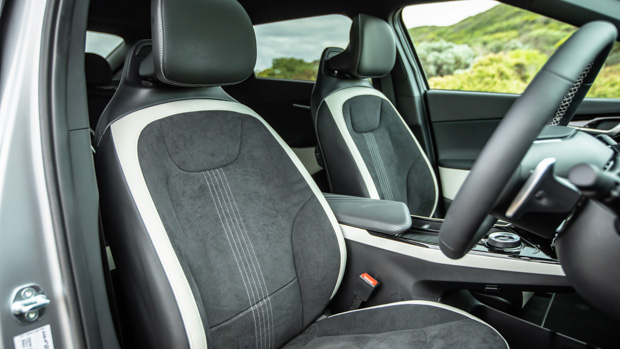
Despite the promise of a Meridian surround-sound stereo in the EV6 GT-Line, we were disappointed with the quality in reality. Despite several stops to adjust the treble, mid, bass, fader, balance and surround settings, we were never able to reach a comfortable balance.
There is a boot-mounted subwoofer that steals 10L of boot space (meaning 480L remaining), but if it was there, we couldn’t feel or hear it. Both bass and treble were sadly lacking in clarity. The Ioniq 5’s Bose unit, the Polestar 2’s Harman-Kardon and the Tesla Model 3’s in-house stereo are all superior.
Material quality is where cost-control is most evident in the EV6. In the front row it’s just okay, though the textures of softer plastic again feel $50K Sportage. Move to the back seat, with its rock-hard and shiny door trims, and you suddenly don’t feel like this adds up to $74,990.
Then there’s rear-seat comfort, which is average at best due to the high floor of the EV6’s skateboard battery which drives the floor height up. The front seats are so adjustable (in the GT-Line) that you don’t notice this, but sitting on the fixed-base rear seat leaves your feet very high.
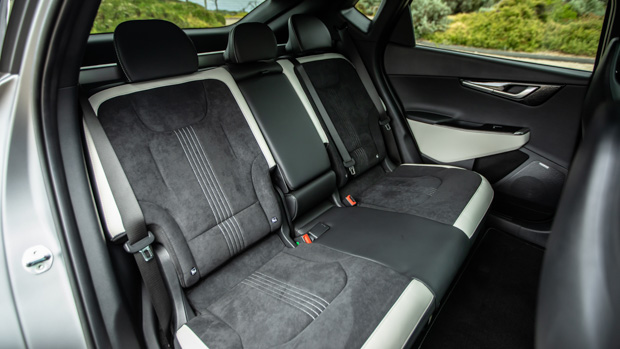
That’s a shame because legroom is comically generous in the second row thanks to the 2.9-metre wheelbase stretched around the battery. In every dimension, the EV6 is huge back there, but a solution needs to be implemented to get passengers’ legs lower – or to improve the seat angle to compensate.
Behind a tailgate that is electric on the GT-Line (but not the Air) sits the 480L of boot space. It’s largely featureless back there, lacking the clever grocery-bag holder function of the Polestar 2, but we fitted a weekend’s worth of stuff without a problem.
Unlike every other Kia in Australia, the EV6 runs without a spare wheel in lieu of a tire mobility kit. Some buyers, particularly in remote locations, will find this to be a dealbreaker.
We’re beginning to notice a trend with vehicles on the Hyundai-Kia-Genesis E-GMP electric-car platform: their energy efficiency is really strong at low speeds but this diminishes more than most at higher speeds.
Our energy consumption dipped as low as 12kWh/100km in town, finally averaging 13kWh/100km at what we’d call commuting speeds. At 100km/h on the highway we were able to eke out 16kWh/100km, but in spirited driving the best we could do was 19kWh/100km. The AWD is thirstier by about six percent.
With its 72.5kWh usable battery, those consumption figures imply a real-world range of about 380km in fast driving, 450km at 100km/h and 550km in urban areas. The latter figure exceeds the urban range of many combustion vehicles, which are least efficient at low speeds.
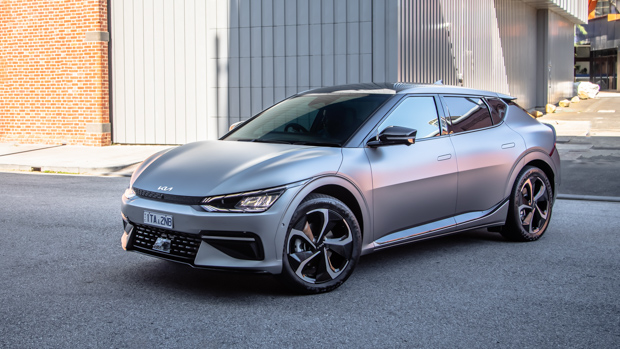
Compared to the Tesla Model 3’s best-in-industry efficiency of 13kWh/100km in combined driving (our testing), the EV6 is a little thirsty – though not so much as our long-term Polestar 2, which sometimes consumes more than 20kWh/100km in urban driving.
However, the EV6 can charge at a maximum of about 240kW thanks to its 800-volt electrical architecture. You will need to find a 350kW-capable charger to extract maximum charging speeds, though when you do you’ll be able to shove about 350km of range into the EV6 in under 20 minutes.
Many owners will choose to install an AC wallbox at their property to charge the EV6, which is capable of charging at 11kW AC speeds. A three-phase installation would allow 11kW home recharging, which would take about 6h 30m, versus 10h 30m for a single-phase 7kW wallbox … and an impractical 36 hours with a traditional three-pin powerpoint.
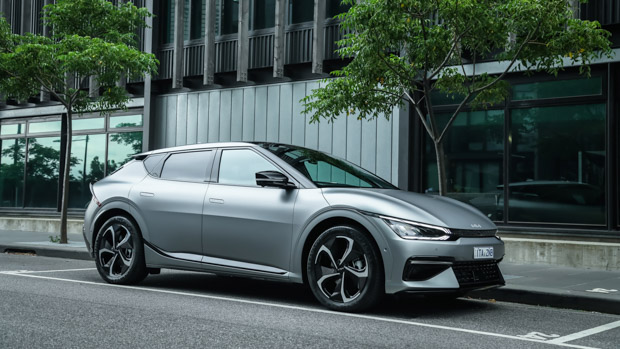
Kia will sell up-front service plans for the EV6. It’ll be advised that owners visit a service centre every 12 months/15,000km – like a combustion vehicle – largely for checks, cabin filter and brake fluid changes. Three years costs $594, five years costs $1089 and seven years – including a more extensive check – costs $1684.
The warranty on the EV6 runs for seven years with unlimited kilometres, but Kia Australia has had to accept the company’s global high-voltage parts warranty which is less generous at seven years/150,000km.
The Kia EV6 is one of the best electric cars on the market today. Its ride is well-attuned to Australian roads, the equipment list is generous, the GT-Line’s seats are comfortable, and you can choose distinct levels of performance: the RWD model’s dynamics are especially entertaining, while the AWD offers strong pace and extra traction.
Much like the Porsche Taycan, a considerable chunk of the EV6’s success comes from the fact that Kia has concentrated on making it a high-achieving car first and foremost, rather than focusing completely on the electrical architecture to the detriment of other things that are very important for cars: ride, handling, comfort, packaging, and tech.
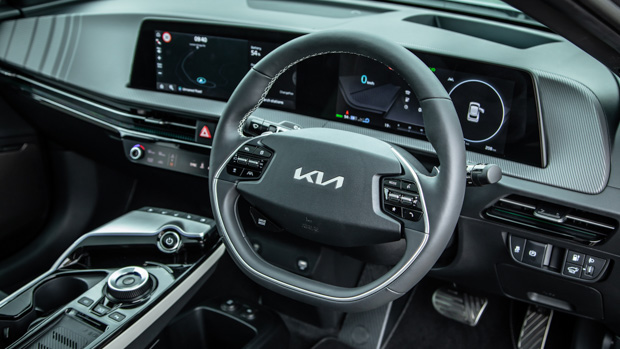
There is a whiff of budget Porsche Taycan to the svelte EV6 – though it’ll take an improved Aussie steering tune, wireless smartphone mirroring, a stereo upgrade and better cabin materials for it to fully justify the $75K price in our eyes.
And it’s such a shame Kia Australia has only been allocated 500 to sell this year, because this car is more than good enough to exceed that tally.
Variant tested GT-LINE AWD (WITH SUNROOF)
Key specs (as tested)
About Chasing cars
Chasing Cars reviews are 100% independent.
Because we are powered by Budget Direct Insurance, we don’t receive advertising or sales revenue from car manufacturers.
We’re truly independent – giving you Australia’s best car reviews.
The estimate provided does not take into account your personal circumstances but is intended to give a general indication of the cost of insurance, in order to obtain a complete quote, please visit www.budgetdirect.com.au. Estimate includes 15%^ online discount.
^Conditions Apply
Budget Direct Insurance arranged by Auto & General Services Pty Ltd ACN 003 617 909(AGS) AFSL 241 411, for and on behalf of the insurer, Auto & General Insurance Company Limited(ABN 42 111 586 353, AFSL 285 571).Because we don’t know your financial needs, we can’t advise you if this insurance will suit you. You should consider your needs and the Product Disclosure Statement before making a decision to buy insurance. Terms and conditions apply.
Indicative quote based on assumptions including postcode , 40 year old male with no offences, licence suspensions or claims in the last 5 years, a NCD Rating 1 and no younger drivers listed. White car, driven up to 10,000kms a year, unfinanced, with no modifications, factory options and/or non-standard accessories, private use only and garaged at night.
^Online Discounts Terms & Conditions
1. Discounts apply to the premium paid for a new Budget Direct Gold Comprehensive Car Insurance, Third Party Property Only or Third Party Property, Fire & Theft Insurance policy initiated online on or after 29 March 2017. Discounts do not apply to optional Roadside Assistance.
2. Discounts do not apply to any renewal offer of insurance.
3. Discounts only apply to the insurance portion of the premium. Discounts are applied before government charges, taxes, levies and fees, including instalment processing fees (as applicable). The full extent of discounts may therefore be impacted.
4. We reserve the right to change the offer without notice.